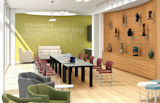How The Modern School Is Becoming More Like The Modern Workplace
As the office has evolved to allow a more creative and collaborative workplace, many educators have taken note, bringing those same features to classrooms, school libraries, lunchrooms and other common areas.
Today’s schools, are now being equipped with outlets from the floors to the walls allowing students to easily plug in and charge laptop computers, phones and other devices wherever they work. They have furniture designed for the way students sit and stand. And they have collaborative spaces designed to allow them to work together in small groups and in teams.This trend began with the charter school boom over the last 7-10 years for several reasons.
First, these schools were less beholden to older educational designs and in many cases even wanted to differentiate themselves from the traditional model. Second, they were starting from scratch, so they had more options when choosing their interior designs and furniture. And third, many have an explicit goal of better preparing students for success in college and in the workforce.Now, these new schools are setting the standard for what people expect of a forward-thinking educational space.
Featured: OFM's Contour Series Mobile Club Chair and Hex Series Stool (in front).
Electrification is the first major change with technology being the driving force. More students are using laptops at their desk instead of in a separate computer lab, so in addition to outlets in the floors and walls, desks and work tables are coming equipped with built-in electrical panels with outlets and USB ports so students can plug in and power up anytime they need to. That’s been harder to do in older schools built in an earlier era, but many are catching up as buildings and classrooms are remodeled.
Ergonomics is the second major force. Standing desks have become popular in offices, especially among middle-aged workers with back problems. But more schools are showing interest in having some standing desks as an option, as well as chairs that encourage good posture and help students strengthen their core. The third shift is even more fundamental. Educators have long since moved past the "one-room schoolhouse" approach where students only sat in rows before a teacher and a chalkboard, but their classrooms didn’t always reflect this. Now, more classrooms are designed to incorporate flexible spaces where students can gather in small groups and even rearrange multi-purpose furniture as needed, while libraries and common areas are designed using furniture to promote collaboration.This reflects the more collaborative approach to work that began in tech companies but has now spread to other professional industries. Schools that want to train the workers of tomorrow are taking heed and giving them the kinds of experiences they need to succeed in these new, less rigidly hierarchical workplaces. These flexible spaces often are filled with lightweight, brightly colored and easily movable stools that can be rearranged to suit a group of any size while also encouraging people to have a more informal and free-flowing conversation. Of course, these changes aren’t necessarily appropriate for every school. But taken collectively, they point toward a new style of learning that is more open, more collaborative and more appropriate for preparing students for the workplaces they’ll enter in years to come. Blake Zalcberg is CEO of OFM, a family-run office and school furniture manufacturer and distributor headquartered in North Carolina with distribution centers there and in Arizona, Pennsylvania, Kansas and Washington state. For twenty years, it has provided affordable and quality furniture through a nationwide dealer network, offering the latest concepts and designs to businesses, and government, health care and educational facilities. Working with manufacturers in Mexico, Taiwan and China, OFM designs furniture to meet the highest industry standards which are sold through a variety of retailers, mail-order catalogs, and online dealers including Staples, Wayfair, Overstock, and National Business Furniture. To learn more about OFM, visit: http://www.ofminc.com
***
This article originally appeared on the Huffington Post on June 28, 2016.
Published
Get the Dwell Newsletter
Be the first to see our latest home tours, design news, and more.

